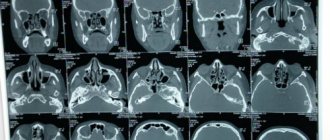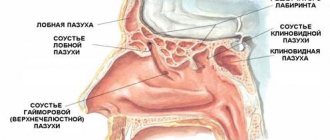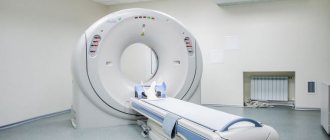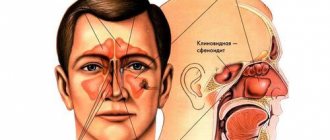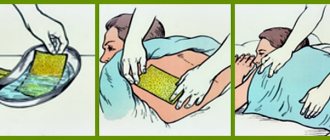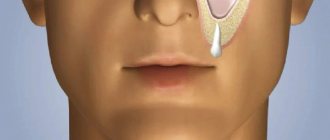Young children, especially in the autumn-winter period, are regularly exposed to a merciless attack of respiratory diseases. Due to insufficient research into the problem or the inability to carry out a full examination, illnesses often progress, involving their faithful companions in the disease - complications.
A significant part of the identified otolaryngological abnormalities are due to inflammation, and they, in turn, can not only complicate the patient’s future life in the absence of treatment, but also cause death. In order to diagnose such disorders in a timely manner, doctors began to use a special safe diagnosis for children - nasopharyngeal endoscopy.
What it is
This procedure is based on the use of a laryngoscope, a medical device with a very thin fiber optic tube. A light-emitting device and a camera are implanted at one end, and an eyepiece at the other, through which a specialist can observe the condition of the ear canals, nasal cavities and upper throat.
Before the main stage of non-invasive diagnostics, anesthesia is performed. Most often, lidocaine gel is used as an anesthetic; sometimes a spray is used. The first drug is lubricated at the very tip of the endoscope “nose”, lightly rubbed along the walls of the nose, which go numb after a few minutes. The second remedy is used to treat the nasal passages - a tolerable tingling sensation contributes to irritation of the mucous membranes.
Next, a tube is inserted into one of the nostrils, the width of which reaches only 2–3 mm. As it moves towards the peripharyngeal ring, the specialist checks the structures for the presence of suspicious formations: scars, polyps, foci of inflammation, pustules, cuts, swellings, etc. Similar actions are performed in relation to the second nasal passage.
Appearance of the narrowed part of the endoscope with a built-in light source
Each manipulation is recorded on the monitor in real time. In the absence of serious pathological changes, the endoscopic procedure will take about 7-10 minutes, perhaps a little more. At the end of the session, the doctor will explain the situation, write out a diagnosis and prepare photographs showing the detected abnormalities.
If, before the start of the study, the patient showed obvious signs of swelling of the nasal mucosa, then the specialist, in addition to the anesthetic, also uses a vasodilator.
Fifth stage of nasal diagnosis: endoscopy of the nasal cavity and sinuses
The most informative modern methods for diagnosing the nose are endoscopic methods. For endomicroscopy of the nasal cavity and sinuses, special optical systems and rigid and flexible endoscopes with different viewing angles are used, which help to see and assess the condition of the nasal cavity and sinuses as accurately as possible. Endoscopic methods for diagnosing the nose are almost completely painless and can be used not only for diagnostic, but also for therapeutic purposes.
A complete step-by-step examination of the condition of the nose and assessment of its functions help to assess the condition of the nose as accurately as possible and complete the process of diagnosing the nose with a reliable diagnosis.
Share:
Indications and contraindications
Children and adolescents are given referrals for endoscopy only if suspicious symptoms are detected. The most common ones include:
MRI of the paranasal sinuses
- decreased hearing sensitivity;
- constant nosebleeds;
- difficulty swallowing or breathing;
- the presence of nodular formations of unknown nature;
- chronic runny nose;
- the presence of foreign objects in the nasal cavity;
- impaired sense of smell;
- noise and ringing in the ears;
- chronic snoring;
- frequent migraine attacks;
- purulent or bloody nasal discharge;
- impaired speech;
- pressing pain in the facial part of the head;
- deformation of the nasal septum.
An endoscopic procedure is also carried out to identify the cause of ongoing headaches that cannot be relieved even with analgesics. Contraindications include, perhaps, only some severe disorders of the central nervous system, intolerance to lidocaine, reduced blood clotting and sensitivity of the nasal mucosa.
For what diseases and symptoms is endoscopy of the nose and nasopharynx prescribed for children?
Nasal endoscopy is prescribed for diseases of the ENT organs, the main ones of which are: sinusitis, tonsillitis, acute respiratory disease, rhinosinusitis, frontal sinusitis.
The procedure makes it possible to identify various pathologies at an early age, the treatment of which in the early stages will be more effective than in an advanced state. Endoscopic examination can detect benign and malignant neoplasms, inflammation of the adenoids and in the sinuses. Polyps are identified through the endoscope. You can also view anomalies in the structure of the nasal passages and septa, and the peculiarities of the nasal mucosa during the disease.
Photo gallery:
Endoscopy of the child’s nose is prescribed for a number of symptomatic features:
- Difficulty breathing, forcing children to breathe through the mouth
- With a decrease or complete disappearance of the sense of smell
- If you have mucus or pus coming from your nasal passages
- Unreasonable headaches in the frontal lobe, or temporal region
- With a decrease in taste buds
- For throbbing pain in the sinuses
- With hearing loss, prevalence of tinnitus
- If you snore during sleep
- Frequently recurring nosebleeds
What violations can be identified
During diagnosis, the otolaryngologist pays attention to suspicious papules, erosion, tumor formations, narrowing of natural passages, spines and areas with perforation. Using endoscopy, an ENT specialist can detect almost any disease associated with inflammation - sphenoiditis, sinusitis, tonsillitis, pharyngitis, sinusitis, frontal sinusitis, ethmoiditis, etc. If the focus of the disease is located in the nasopharynx, it is highly likely to be detected.
Another reason for endoscopy of the ENT organs is trauma to the facial bones.
What is nasopharyngeal endoscopy?
This procedure is prescribed for suspected inflammatory disease of the respiratory system affecting the lower nasal cavity. Endoscopy of the nasopharynx allows you to see changes that have occurred in diseased organs, which increases the accuracy of the diagnosis.
During the procedure, the child is examined with an endoscope. This device resembles a long tube of small thickness (2–4 mm). A flashlight is located at the end of the device to increase visibility.
Next to the lighting device there is a camera that allows you to display the image on the monitor screen behind which the doctor sits. Tubes can be soft, very thin, hard or bendable. The device consists of several parts:
- frame;
- connection cable;
- working part;
- working end control handle;
- monitor;
- lighting cable;
- lighting cable connector;
- power cable connector;
- distal end.
Nasal endoscopy is absolutely painless. The procedure is highly accurate and allows you to see pathologies in the early stages. This allows you to make a diagnosis with high accuracy.
Endoscopic examination is often combined with surgical procedures. This allows you to remove tumors quickly and in the least traumatic way. This operation leaves no marks on the face, and blood loss is minimal. The patient is sent home on the second day. This significantly reduces the number of days on sick leave.
At what age are you allowed to do research?
Endoscopy of the nose for a child under 2–3 years of age is rarely performed, since children of this age category cannot always remain in a static position for about 10 minutes. Any sudden movement made during diagnosis threatens damage to the mucous membrane of the nasopharynx. Children are given referrals to an ENT specialist only if special indications have previously been identified.
Before endoscopy, several tests are often prescribed to rule out intolerance to any components of the anesthetic.
Contraindications
As a rule, endoscopic examination of the nasopharynx does not cause side effects or complications, so there are only two contraindications to the procedure: an allergy to local anesthetic and a tendency to nosebleeds. If such conditions are present, the patient should notify the doctor before the examination. If you are prone to bleeding, the doctor will perform an endoscopy with a thin device designed for examining children. The procedure is performed with great care if the mucous membrane is overly sensitive.
Sometimes ENT doctors do not resort to examining the nasopharynx with an endoscope in case of certain neurological disorders, so as not to provoke an attack in the patient. If the presence of an allergy has not been declared, then the occurrence of allergic intolerance to the anesthetic during the procedure is accompanied by the following symptoms:
- swelling of the larynx and pharynx;
- hyperemia of the mucous membrane;
- increased body temperature;
- itchy feeling in the throat;
- watery eyes and sneezing;
- labored breathing.
If signs of an allergy appear, the patient needs urgent help. The doctor must provide access to fresh air, unbutton clothes, and administer an antihistamine intravenously. If the case is severe, then additional hormone therapy is performed. After first aid is provided, the patient is hospitalized in a hospital under the supervision of medical staff for several days.
Description of the procedure
An otolaryngologist prescribes an endoscopic examination for the child; he recommends going through the procedure if there are difficulties in making a diagnosis.
The study is carried out in compliance with several rules, in order for it to take place it is necessary:
- Explain to the child why he is being examined.
- Explain the mechanism of action and manner of behavior.
The child must understand how to behave and that attempts to contact the doctor will lead to an increase in the duration of the examination, and undesirable consequences will arise at the time of its conduct.
But what to do when your nasopharynx hurts and what medications are the most effective.
How the research works
- the child is seated on a chair or armchair;
- the doctor asks him to tilt his head back slightly;
- The doctor inserts a small tube into the baby’s nasal passage.
The video shows how the procedure is carried out:
An endoscope is a device that is a small (in diameter) tube with a camera at its end that transmits an image to a monitor.
The doctor sees a picture on the monitor, assesses the condition of the mucous membrane, and upon completion of the procedure prints out photographs of problem areas.
At this point, the study can be considered completed; many parents are worried about the sensations that the baby experiences at the time of insertion of the endoscope. Anticipating possible questions and concerns, it is worth noting that the examination is carried out using an anesthetic (lidocaine in the form of an ointment or spray).
The anesthetic is applied directly to the endoscope; for this reason, its administration does not lead to the development of unpleasant sensations. The use of this product irritates the mucous membrane, which means it facilitates the process of removing the cutting. But what to do if inflammation of the nasopharynx occurs and what can be done about such a problem.
But the procedure is not carried out if there are contraindications, these include:
- Mental illnesses in a child in which he cannot remain calm for a specified period of time: autism, dementia, ADHD.
- Frequent nosebleeds of unknown etiology (the procedure may cause blood loss).
- Intolerance to the main active ingredient of the anesthetic.
If a child has an allergic reaction to lidocaine or novocaine, then parents should notify the doctor.
You may also be interested in information about what to do when mucus flows down the nasopharynx.
How is the procedure performed?
An endoscopic examination is done following certain rules. It all starts with a visit to an ENT doctor.
If there is evidence, he recommends the procedure, finds out from the parents or the child himself:
- Are there any complaints that may indirectly or directly indicate the presence of indications for an examination?
- The presence of allergic reactions to lidocaine or novocaine.
It is worth noting that the procedure may cause certain sensations, including pain, provided that the child’s nasal passages are narrowed. This is considered an anatomical feature of the structure of the nasopharynx. In this case, the procedure is called into question.
How is the examination carried out?
- the endoscope is treated with an anesthetic and antiseptic solution;
- then they gradually introduce it into the nasal sinus, examining it with a camera;
- The doctor examines the result personally and makes a diagnosis for the little patient.
On average, the study lasts from 2 to 5 minutes; if it is performed on an infant, then the parents record the position of the baby.
It is important that the baby does not move and does not create unnecessary interference. Otherwise, the child risks injury and damage, and the procedure may be disrupted.
